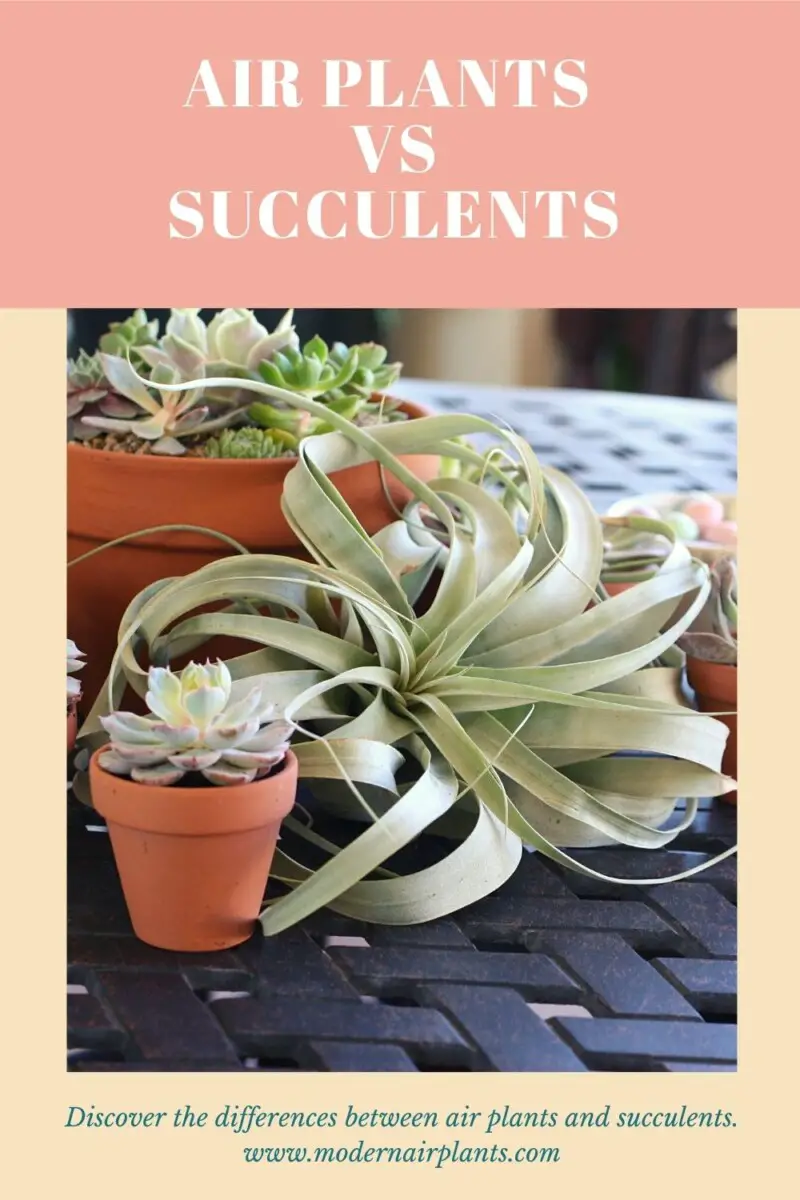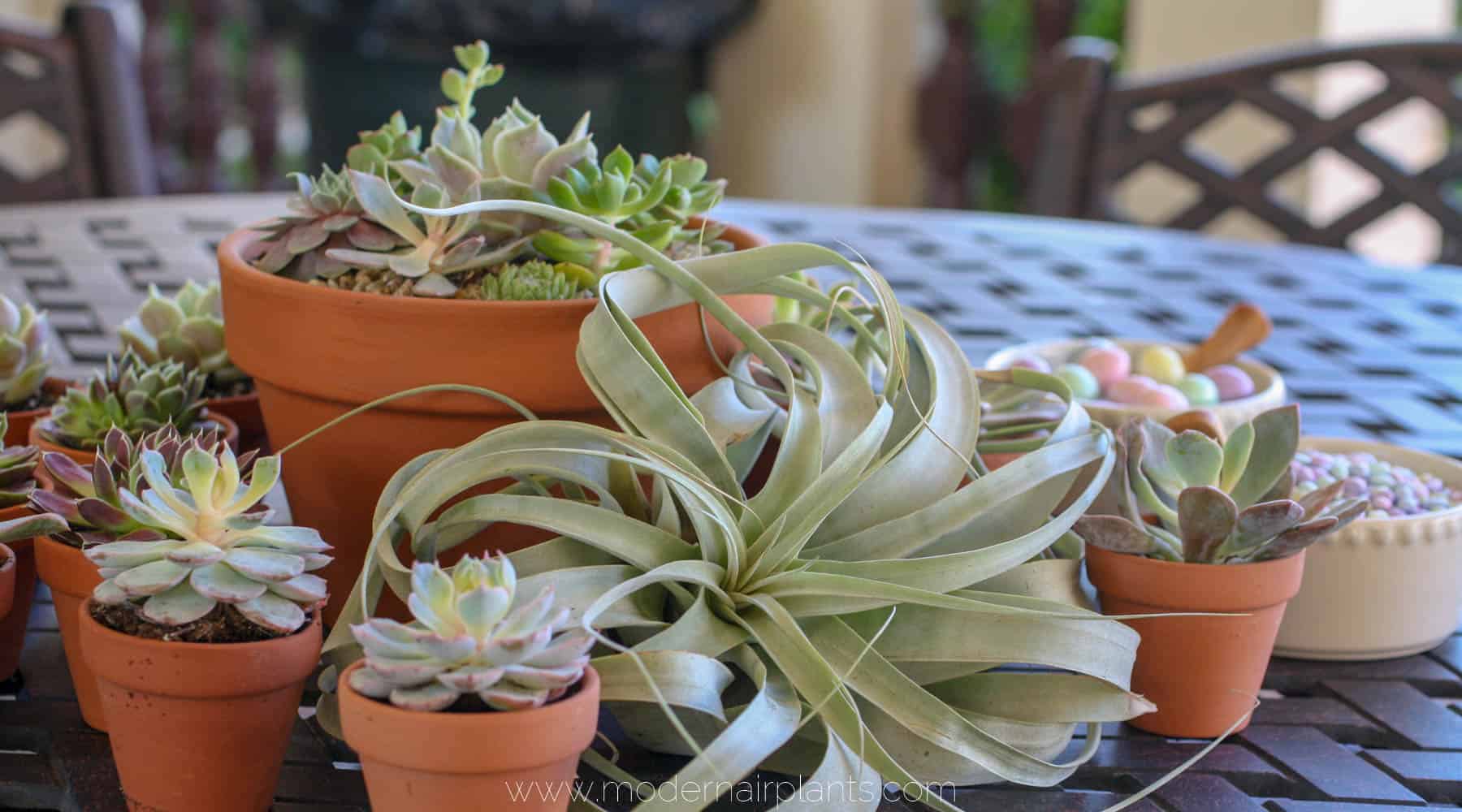Are Air Plants the Same Thing As Succulents?
Air plants and succulents have become constant favorites for plant lovers. Their peculiar appearance makes them very special and adds an alluring tone to any home style. Besides, they need minimal maintenance to survive, which makes them ideal for those without green thumbs. However, many people mix up the two varieties.
This post may contain affiliate links, and I love all the products I promote.
Air plants are not the same as succulents. Succulents are plants with puffy or juicy parts, while air plants are a specific genre with spiky leaves. The most significant difference is that air plants absorb their nutrients from the air and spray watering, but succulents live and feed on the soil.
In this article, you will find out more about the differences between the two varieties, including their appearance and species. You will also learn what type of environment each plant needs to survive and thrive.

Air Plants vs. Succulents
Air plants are a small family of plants that get most of their nutrients from the surrounding air, as opposed to soil. These greens circle their scrawny little roots around any hanging surface to gain stability and use their leaves to soak up any nutrients they can find.
They mostly live on the brushwoods, cliffs, beams, housewalls, and even electric wires. That is why they are often used as decorative pieces.
Succulents, on the other hand, are soil-based plants that thrive in a pod or garden, just like any other tree or flower. Besides, they are much more versatile compared to air plants.
Another difference is in terms of appearance. While succulents have thick, flesh-like leaves, air plants have spiky tendrils with a feathery appearance.
The scientific name of air plants is Tillandsia because they are members of the Tillandsia genus, but “air plant” sounds like a good nickname for their air-dependent nature.
Air Plants vs. Succulents Species
The Tillandsia genus belongs to the bromeliad kind—a group of monocot flowering plants, with pineapple as its most popular variety. This genus includes nearly 650 species. Some of them are as small as the 0.5-inch ionantha, and others can be as tall as the seven-foot butzii.
Here are the most common types of air plants:
- T. ionantha: With its vibrant silver leaves and purple flowers, ionantha is the most popular air plant species. It turns into a beautiful red color before it produces any offsets.
- T. cyanea: Also known as the pink quill plant, this type of Tillandsia is unique because it can grow both in the soil and through the air. It has pink or purple bracts with pointed needle leaves and grows no more than 12 inches.
- T. aeranthos bergeri: This is a low-maintenance air plant that blooms blue and pink flowers with prickly patterns. Some people also call it mad puppers.
- T. tectorum: This one has hairy trichomes on its leaves, resembling the shape of a snowball. Although it is a bit more expensive than other species, the T. tectorum can add a unique tone to your yard, sunroom, or patio.
- Click here, to see where I like to buy air plants.
Unlike air plants, succulents do not belong to a specific genus. Instead, you can find one or more species of succulents within different plant families. More specifically, any plant with swollen watery leaves can fall into the succulents category, no matter if it is a Cactus, Yuccas, Agave, or even Dogbane.
Here is a brief list of the most common succulent species:
- Aloe Plants: This is a familiar succulent with spiky leaves. Aloe Black Beauty, Aloe Crosby’s Prolific, Aloe Doran Black, and Aloe Helskloof Bells are among the most beautiful ones.
- Aeonium: These succulents appear in spoon-shaped leaves and multiple colors. They can also grow red, pink, yellow, or white flowers in warm seasons.
- Jade plant: Also known as the money plant, the jade plant looks like a small tree with miniature egg-shaped leaves and woody branches.
How to Grow Air Plants vs. Succulents
Naturally, air plants grow above the ground and on the branches of other plants. To grow an air plant in a house setting, though, you should first soak it in water for about half an hour once a week. Then, suspend it somewhere upside down, allowing the crown of the air plant to completely dry.
After several hours or even a day or so, mount the plant where you want it to grow. You are free to put air plants pretty much anywhere you want: on the interior pillars, your favorite sculpture, threads hanging from the ceiling, or inside a glass bowl. Click here, for ideas on how to display your air plants.
The only restriction is that the plant should receive enough sunlight, moderate temperatures, and moisture. Never confine your air plants to a sealed vessel or unventilated area.
To grow succulents, pick a porous, well-draining pot and fill it with slightly acidic soil. Garden soil will usually do the job, but you can also make your blend by mixing a portion of grit, coarse sand or perlite, with two portions of compost.
Ideally, you should put the pot on a windowsill on the southern side of the house.
How to Maintain Air Plants vs. Succulents
Watering
As a rule of thumb, succulents are drought-resistant plants that can store water in their leaves and survive an extended water deficit period. However, a few factors affect their ability to do so, including the season, their species, and their planting place.
For example, succulents with thinner and less fleshy leaves retain less water, so you should keep watering them more frequently. Pot-planted succulents need more regular watering than those planted in the garden. Similarly, newly-planted succulents tend to be more thirsty than older ones.
The environment and time of the year also matter. In summer or hot climates, succulents enjoy more watering than in the winter, autumn, or cold weather.
As you know by now, air plants do not need soil or water, but it does not mean they do not need watering. The point is, you should water them in a whole different way than succulents.
The first and easiest way is through spraying or misting. Generally, you should spray water on your air plants three to seven times a week, but if you live in a place with high humidity or habitual rainfalls, this may reduce to once or twice a week.
Rinsing is another practical but demanding option because it requires you to detach the plant from its container. Put the plants in a sieve and gently hold them under the tap water at the sink. This method is especially helpful when you are in a hurry and know the plant’s running out of water.
The last and best method is dunking or soaking the plant. Fill a bowl with water, and submerge the plants. Let them be there for a few hours and repeat the process every week. You can also adopt a combination of all three methods. Click here, to learn more about how to properly water air plants.
After soaking an air plant in water, be sure to let it dry upside down to prevent water from accumulating in the cup of the plant and causing rot. Click here, to learn more about how to properly dry air plants.
Light
To develop healthy green leaves, succulent plants need direct sunlight exposure for about five to seven hours a day. In contrast, air plants appreciate indirect sunlight to show their best colors.
Air plants like bright indirect light, though they do not need it as much as succulents do. Cloudy weather with intermittent glimmers of light or afternoon sunshine is the best light source for air plants. Click here , to learn more about how to provide light for your air plants.
Conclusion
Although some people mistake succulents for air plants, they come from two different worlds. Succulents are soil-based plants that need compost and manual watering to survive, but the air plants rely on the air. They also need specific watering methods such as misting and soaking.
They are also different in terms of appearance. Succulents have thick, flesh-like leaves, whereas air plants have spiky tendrils with a feathery appearance.
Sources
- Succulent City: Comparison: Air Plants vs. Succulent Plants
- Succulents and Sunshine – How to Grow Succulents Indoors
- Zillow: Air Plants and Succulents: A Perfect Pair
- Succulents Network: Air Plant Succulent Guide
- Drake Magazine: GROW AND CARE WITH AIR: AIR PLANTS & SUCCULENTS
- The Spruce: 25 Recommended Air Plants to Grow Indoors
- Better homes: Succulent plants: 11 types of succulents


